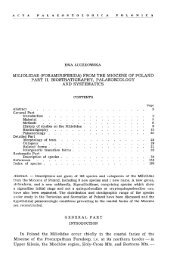The skull of Velociraptor - Acta Palaeontologica Polonica
The skull of Velociraptor - Acta Palaeontologica Polonica
The skull of Velociraptor - Acta Palaeontologica Polonica
You also want an ePaper? Increase the reach of your titles
YUMPU automatically turns print PDFs into web optimized ePapers that Google loves.
ACTA PALAEONTOLOGICA POLONICA (44) (2) 199<br />
<strong>of</strong> the frontal. As preserved in GIN 100124 and 25, a small caudolateral angle <strong>of</strong> the lacrimal extends<br />
outwards, slightly beyond the orbital margin <strong>of</strong> the frontal. As seen on the broken surface <strong>of</strong> the lacri-<br />
mal shaft in the ZPAL MgD-U97, at least its dorsal portion was pneumatized, and there is a small<br />
ventral aperture at the base <strong>of</strong> the horizontal portion. This aperture is located above the much larger,<br />
funnel-like 'lacrimal canal' visible on the caudal surface <strong>of</strong> the shaft. <strong>The</strong> lacrimal recess seems to ex-<br />
tend also into the base <strong>of</strong> the rostral process <strong>of</strong> the dorsal horizontal portion <strong>of</strong> the lacrimal. As seen<br />
from the side, the shaft is straight for most <strong>of</strong> its length. In the caudal view, however, it is arched<br />
dorsomedially. <strong>The</strong> shaft is narrow in the sagittal direction and expanded transversely. Its surface<br />
facing the antorbital fossa is excavated. This excavation extends dorsally and rostrally along the ro<strong>of</strong><br />
<strong>of</strong> the antorbital fossa. Ventrally, the concavity on the shaft becomes deeper, and close to the contact<br />
with the jugal it passes into a deep, funnel-like recess, which penetrates the base <strong>of</strong> the lacrimal<br />
ventrocaudally. <strong>The</strong> dorsal lacrimal-maxilla contact within the fossa is indistinct in all our speci-<br />
mens. <strong>The</strong> lacrimal shaft is well exposed medially in ZPAL MgD-1/97. This specimen shows that the<br />
ventral extremity <strong>of</strong> the shaft extends caudolaterally-rostromedially. <strong>The</strong> ventral end <strong>of</strong> the shaft has<br />
an extensive contact with the jugal and an inclined, triangular facet medially for contact with the pala-<br />
tine. In this specimen, there is no ventral contact with the maxilla, the maxillary process <strong>of</strong> the jugal<br />
separating these two bones ventrally.<br />
Postorbital. - <strong>The</strong> triradiate postorbital forms most <strong>of</strong> the caudal boundary <strong>of</strong> the orbit in GIN<br />
100125, but not in PIN 3 14318, in which the jugal bounds most <strong>of</strong> the caudal orbital margin. <strong>The</strong> fron-<br />
tal process <strong>of</strong> the postorbital is directed dorsally and medially, and its end contacts the frontal above<br />
and the laterosphenoid below. Contact with the frontal is much more extensive than with the<br />
laterosphenoid. <strong>The</strong> medial flexion <strong>of</strong> the frontal process is almost at right angles to the squamosal<br />
process. <strong>The</strong> latter process deviates caudally 20"-30" from the longitudinal axis <strong>of</strong> the <strong>skull</strong> to help<br />
form the short, laterally bowed supratemporal arcade.<br />
Squamosal. - <strong>The</strong> squamosal has four prominent processes: the ventral (= prequadratic) process,<br />
the caudal (= paroccipital) process, the rostral (= postorbital) process and the medial (= parietal) pro-<br />
cess. <strong>The</strong> prequadratic process is relatively short and subtriangular. Its extensive, oblique caudo-<br />
ventral edge contacts a triangular rostrolateral flange <strong>of</strong> the quadrate (Figs lA, B, 4A). <strong>The</strong> ventral<br />
apex <strong>of</strong> this process also has a short contact with the ascending process <strong>of</strong> the quadratojugal (see be-<br />
low). On the occipital surface <strong>of</strong> the <strong>skull</strong>, the caudal process is well exposed dorsal to the opisthotic.<br />
It slopes slightly caudoventrally in lateral view. Rostrally, the postorbital process diverges from the<br />
long axis <strong>of</strong> the <strong>skull</strong> at an angle <strong>of</strong> about 35". <strong>The</strong> parietal process is directed rostromedially and<br />
slightly ventrally, and invades a narrow sulcus on the parietal, above the ventral contact <strong>of</strong> the latter<br />
bone with the prootic. It forms the ventral part <strong>of</strong> the steep caudal wall to the supratemporal fossa.<br />
<strong>The</strong> angle between the parietal and postorbital processes is about 80". <strong>The</strong> cotyla for the head <strong>of</strong> the<br />
quadrate is not well exposed. A sharp crest extends along the lateral surface <strong>of</strong> the squamosal, which<br />
caudally transforms into a shelf overhanging the prequadratic process and extends lateral to the<br />
quadrate cotyla.<br />
Quadrate. - <strong>The</strong> quadrate seems not pneumatic and has a single-headed otic process. In lateral as-<br />
pect, the ventral third <strong>of</strong> the quadrate shaft is perpendicular to the ventral margin <strong>of</strong> the <strong>skull</strong>. More<br />
dorsally, the shaft inclines somewhat backwards. Close to mid-height, the rostrolateral edge <strong>of</strong> the<br />
shaft expands into a large, triangular flange directed rostrally and slightly medially. <strong>The</strong> rostrodorsal<br />
margin <strong>of</strong> this flange contacts, along its almost entire extent, the prequadratic process <strong>of</strong> the<br />
squarnosal, except rostrally where a tip <strong>of</strong> the quadratojugal inserts between these bones. <strong>The</strong> head <strong>of</strong><br />
quadrate is narrow. In caudal view, the shaft <strong>of</strong> the quadrate is bowed to produce a concave lateral<br />
edge which forms the medial boundary to the large, tall paraquadratic (= quadrate-quadratojugal) fo-<br />
ramen. <strong>The</strong> mandibular process is transversely expanded and is divided into mandibular condyles by<br />
a shallow groove. <strong>The</strong> lateral condyle is larger than the medial one, and bears the mediolaterally ex-<br />
tended articular surface. <strong>The</strong> articular surface on the medial condyle is oriented obliquely (rostro-<br />
medially-caudolaterally) to the median axis <strong>of</strong> the <strong>skull</strong>. <strong>The</strong> mandibular articulation projects a little<br />
below the alveolar margin <strong>of</strong> the maxilla.

















